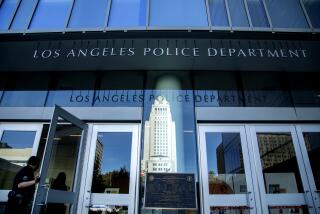L.A. Needs to Merge on the Information Superhighway : Police: LAPD needs to come of age technologically. The department is woefully under-computerized.
If the Los Angeles Police Department hopes to regain its 40-year reputation as a cutting-edge law-enforcement agency, it must tackle some tough challenges. First and foremost, the department must increase the number of officers on the street, and it must implement a citywide community-policing model. But an equally crucial challenge, and one that directly impacts the long-term success of the community-policing effort, is the department’s ability to tap into the technological advances of the 1990s.
At present, the LAPD is sorely handicapped by its lack of modern technology. While Hollywood portrays the LAPD as a technology-sophisticated agency in such movies as “Speed,” the department’s crime-combatting tools more accurately resemble those used by Sgt. Joe Friday in the 1960s “Dragnet” series.
It’s deplorable that the nation’s third-largest police department, with about 7,900 officers and 2,600 administration personnel, has only 721 computers. That’s enough for only 7% of the staff. In addition to computers, the department desperately needs fingerprinting-identification equipment and other communications devices.
The effects of this technology gap are far-reaching. Residents calling emergency numbers receive busy signals. Officers spend up to 40% of their time completing paperwork--time that could be spent on the street solving crimes.
Modernizing our police department would liberate police officers from hours of tedious paperwork and put them back in our neighborhoods. The technology to improve law enforcement already exists. Other police departments across the nation have already installed integrated-computer systems that provide on-line, up-to-the-minute information about suspects, stolen property, outstanding warrants and crime patterns.
Here in California, Newport Beach, Seal Beach and San Diego (among others) are on-line and have already outpaced Los Angeles in implementing these tools and realizing their effectiveness. The LAPD must get on-line too.
To address this urgent need, the City Council’s public-safety committee has scheduled a hearing for Monday.
There have been some isolated attempts to bring technology into the department; officers have brought their own personal computers into the office and devised programs. Some divisions and communities have organized campaigns asking corporations to donate used equipment. In the West Valley, officers have decreased desk hours and increased street time by 40% by using computers to write their reports. And the number of prosecution filings by the city attorney’s and district attorney’s offices increased 17% principally because of their improved clarity.
These individual efforts are important, but we need a departmentwide solution.
The good news is that help is under way to put the LAPD on the communications superhighway. Mayor Richard Riordan has galvanized a coalition of leading business executives under the banner of “The Mayor’s Alliance for a Safer L.A.” The alliance has pledged to raise an unprecedented $15 million in six months from businesses and residents. The funds will be used to purchase the main computer system that will provide the LAPD with voice mail, data processing and networking capabilities.
Within the first year on-line, the alliance estimates computers could save the LAPD about 640,000 hours annually. That’s the equivalent of 368 additional officers on the street. And this computerization would result in a $52-million savings for recruiting, training and benefits costs.
While the alliance’s efforts are an invaluable first step to computerize the LAPD, the city must do its part. We cannot rely solely on the charity of our residents to fund woefully needed upgrades in crime-fighting tools.
To be fully successful in adopting the community-policing model, the LAPD needs to re-engineer the basic processes under which it operates. Through organization and the intelligent application of appropriate technology, dramatic improvements can be made in productivity and in the effectiveness of officers.
The mayor and City Council have a plan to create a police force of 10,000 officers, but Los Angeles will only have done half its job if it does not also integrate new and high technology within that force to combat crime and enhance public safety.
As resources and funding have dwindled over the past 10 years, the LAPD has been forced to choose between salaries, training and equipment. Hiring additional officers and paying them competitive wages have been the understandable top priorities. Now we must expand our focus. The city must identify the improvements needed, find the funds and equip the LAPD with the technology it desperately needs if we are to realize our goals for a safer Los Angeles.
More to Read
Sign up for Essential California
The most important California stories and recommendations in your inbox every morning.
You may occasionally receive promotional content from the Los Angeles Times.










